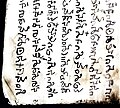| Lai Tay script | |
|---|---|
 The word "Tai Yo" written in the Lai Tay script The word "Tai Yo" written in the Lai Tay script | |
| Script type | Abugida |
| Time period | 16th century – present |
| Direction | Top-to-bottom, right-to-left |
| Languages | Tai Yo |
| Related scripts | |
| Parent systems | Proto-Sinaitic alphabet |
| Sister systems | Sukhotai, Khom Thai |
| ISO 15924 | |
| ISO 15924 | Tayo (380), Tai Yo |
| This article contains phonetic transcriptions in the International Phonetic Alphabet (IPA). For an introductory guide on IPA symbols, see Help:IPA. For the distinction between , / / and ⟨ ⟩, see IPA § Brackets and transcription delimiters. | |
| Brahmic scripts |
|---|
| The Brahmi script and its descendants |
| Northern Brahmic |
| Southern Brahmic |
The Lai Tay script (Vietnamese: Chữ Thái Lai Tay), is a writing system used by the Tai Yo people of Quỳ Châu District, to write the Tai Yo language.
Names
The Lai Tay script means "the script of the Tai". It is also known by various other names such as the Yo Lai Tay script, Nge An script, Tai Yo script, Thai Lai Tay script, Quy Chau script.
Origin
The scholar Ferlus classifies the Lai Tay script as a part of the Khmer family of writing systems, which the scholar divides into two groups: the central scripts consisting of the ancient Sukhothai and Fakkham scripts, which developed into the modern Thai and Lao scripts, and the peripheral scripts of the Tai peoples of Vietnam, which include the Tai Dam, Tai Don, Tai Daeng, Lai Tay and Lai Pao scripts. Ferlus suggests that the Tai peoples all adopted the same first model of writing borrowed from the Khmers, by simple contact during exchanges, without proper learning. Subsequently, the Tai migrated and occupied a large part of Southeast Asia. The peripheral scripts still retain many characteristics of the primitive Khmer-borrowed script, such as pre-Angkorian sound values of certain letters, a lack of alphabetical order and a lack of numerals. The scripts used by the Tai peoples of Vietnam arrived there as early as the 16th century.
Characteristics
The Lai Tay script has 29 consonants, of which 8 can occur in the syllable final position. The script has 13 vowel signs, which are placed below the consonant for most vowels, or to the right of the consonant for a few other vowels. Unlike other Tai writing systems, the Lai Tay script has remained a true abugida, and consonants written without a vowel sign are pronounced with the inherent vowel <o>, . The script contains 9 ligatures for vowel and final consonant combinations.
The script is written vertically from top to bottom and horizontally from right to left on the model of Chinese writing. This innovation, which is unique in southeast Asia, is very well explained by the influence of Chinese writing; Tai scholars found it more convenient, when translating between Tai and Chinese, to adopt the same writing direction for both scripts. The outline of the Lai Tay script is very different from the neighboring scripts and the old type which served as a model for the verticalized type is no longer known.
The Lai Tay script does not contain any tone markers. The script is mostly written without any punctuation marks, but they might be found in some manuscripts, where they are the same as traditional Chinese punctuation marks. The script does not contain any numerals, and numbers were traditionally spelled out.
-
 Text in the Lai Tay script
Text in the Lai Tay script
-
 Excerpt from a Lai Tay manuscript
Excerpt from a Lai Tay manuscript
-
 Manuscript written in the Lai Tay script
Manuscript written in the Lai Tay script
Usage
The Lai Tay script is now out of common use, but there are enough manuscripts to allow linguistic study. Some very old Tai Yo scholars can still read the manuscripts. Manuscripts are preserved in both private and in personal collections. The script is now being taught and studied by the Tai Yo community, with the support of the local government and teachers.
Unicode
The script has been proposed to be encoded by Unicode.
References
- ^ Mukdawijitra, Yukti. "LANGUAGE IDEOLOGIES OF ETHNIC ORTHOGRAPHY IN A MULTILINGUAL STATE: THE CASE OF ETHNIC THÁI ORTHOGRAPHIES IN VIETNAM" (PDF): 95.
{{cite journal}}: Cite journal requires|journal=(help) - ^ Nguyen, Viet Khoi; Sam, Cong Danh; van de Kasteelen, Frank (13 July 2022). "Preliminary Proposal to encode the Yo Lai Tay Script" (PDF). Retrieved 1 September 2022.
{{cite journal}}: Cite journal requires|journal=(help) - ^ Ferlus, Michel (Sep 1999). "Sur l'ancienneté des écritures thai d'origine indo-khmère".
{{cite journal}}: Cite journal requires|journal=(help)
External links
| Writing systems | |
|---|---|
| Index of language articles | |
| Overview | |
| Lists |
|
| Types | |
| Current examples | |
| Related topics | |